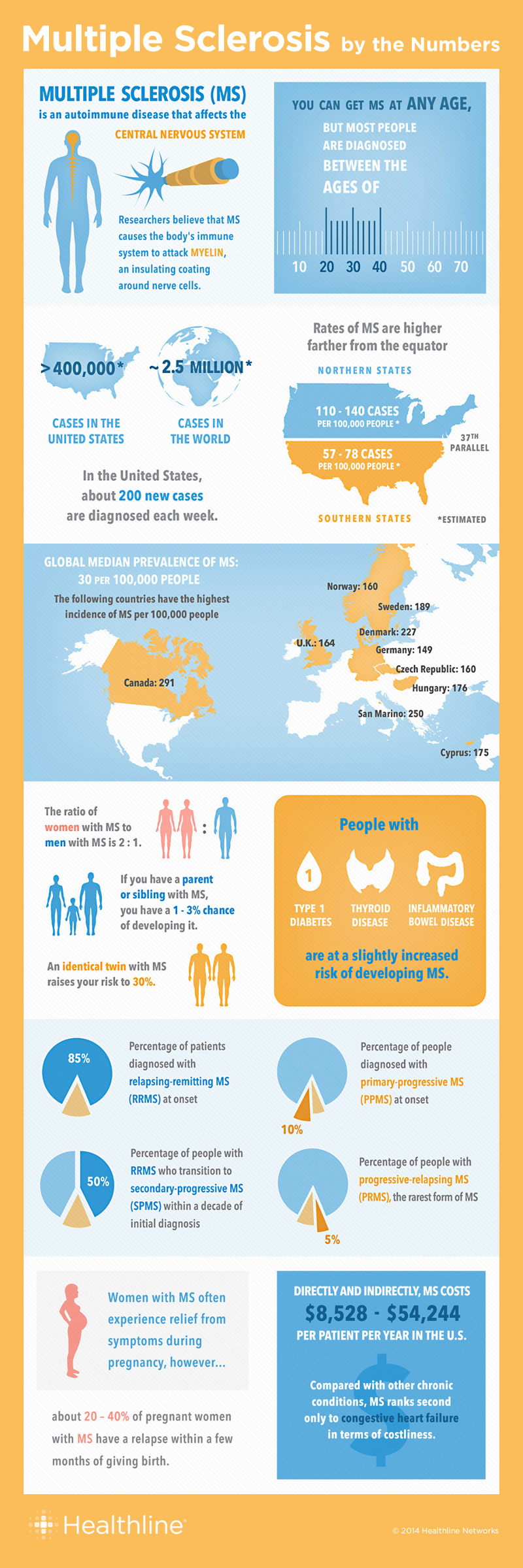Who gets Multiple Sclerosis [MS]? More than 2.3 million people around the world have been officially diagnosed with this disease. It’s not contagious or inherited, but people who live in the northern climates tend to be diagnosed more frequently with it than other global locations.
There is no single test that can help a doctor determine if a person has MS.
What is unique about MS is that when people move to different locations, they assume the local risk levels for disease development. Sometimes this may not appear until the next generation, but the geographic characteristics of MS are unique in the field of human health.
What Are the Chances of MS?
- The average US citizen has a 0.1% risk of developing multiple sclerosis over the course of their lifetime.
- People who have a first-degree relative who has been diagnosed with MS have a 2.5-5% risk of having the disease themselves.
- Identical twins have a 25-30% chance of developing MS if their twin has been diagnosed with the disease.
- MS occurs in most ethnic and racial demographics, but is most common within the Caucasian community.
- Most people are diagnosed with MS between the ages of 20-50, but anyone of any age can be affected by this disease.
Multiple sclerosis is a difficult disease to diagnose because the symptoms can be very different for people. Some people may feel lethargic all day and have burning sensations that are painful. Others may experience more energy than normal and have prickling, stinging, or numbness. Some people can control their bowels, while others struggle with it. Because the central nervous system is attacked, doctors must rule out other causes before coming to an MS diagnosis and that takes time. Attacks can come and go as well, further complicating the issue.
How Prevalent Is MS?
- About 200 new cases of MS are diagnosed in the United States every week, which means there is more than 400,000 people living with the disease very day.
- The rates of MS are 2x higher for populations that live above the 37th parallel.
- Canada has the highest population median for MS at 291 per 100,000 people. That’s nearly 3x what the US rate happens to be.
- Native Americans and Asians tend to have the lowest risk factors for MS development.
- Women are 2x more likely to be diagnosed with MS when compared to men.
- People with IBD, Type 1 Diabetes, or thyroid disease are at an increased risk of developing MS at some point in their lives.
The easiest way to lower an individual and family risk for the development of MS is to move below the 37th parallel. Risk factors are also lowered when living in a climate that is warmer than what is experienced in the colder northern reaches or extreme southern areas of the planet. There may also be some risk factors associated with certain viral infections as well. The truth is that anyone can become part of the multiple sclerosis demographics, so understanding what this disease can do is important for us all.
What Type of MS Could It Be?
- 85% of multiple sclerosis cases are diagnoses as relapsing-remitting. This means symptoms can come and go.
- Half of those who are diagnosed with relapsing-remitting MS will transition into a secondary-progressive form of MS within the first 10 years after their initial diagnosis.
- Only 10% of people with MS are diagnosed with the primary-progressive form of the disease at its onset.
- Progressive-relapsing MS is the rarest form of the disease, accounting for just 5% of the total population living with this disease.
- Up to 20% of people diagnosed with MS have what is known as a benign form of the disease. Their symptoms are typically milder than others and they experience very little disease progression.
- Only 1% of those diagnosed with MS experience a rapid and immediately progressive form of the disease.
Vision problems, dizziness, vertigo, and problems with balance or coordination are common symptoms that people with MS experience. Tingling, numbness, and burning sensations are also common. Some people may have trouble swallowing, begin to experience mood swings, and even have difficulty walking. With a dozen approved medications that modify the progress of the disease, MS is not as difficult a diagnosis as it used to be. People with MS are still active, play sports, get involved with their community, and spend time with their family and friends. It may be a difficult diagnosis to hear, but it can be managed and this is good news.

Although millions of people visit Brandon's blog each month, his path to success was not easy. Go here to read his incredible story, "From Disabled and $500k in Debt to a Pro Blogger with 5 Million Monthly Visitors." If you want to send Brandon a quick message, then visit his contact page here.
